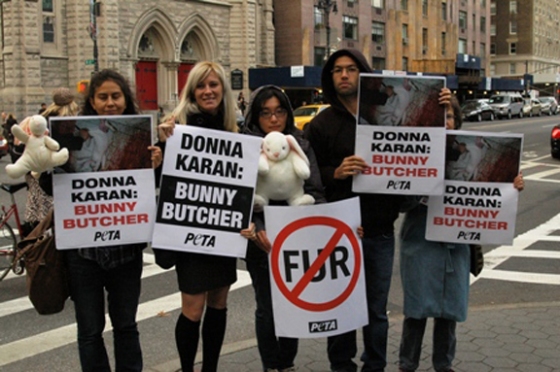The fur industry is often targeted unfairly by members of groups like PETA. While PETA is technically against using animals in any way (including keeping them as pets!), they never seem to be as aggressive towards the meat eating populace as they are to fur wearers. In the past, PETA has gone out of their way to interrupt fashion shows, attack designers outside of their stores, and stage gruesome public displays against fur. They usually make the claim that no one should wear fur because it is an excessive luxury and the fur industry is wasteful, capturing the animals only for their fur and not using any other parts.
The argument that the fur indsutry is “wasteful” is completely unfounded. While we may not think of animals like beaver, muskrat, raccoon and rabbit as conventional food, many people do consume these animals as a part of their diet. What isn’t consumed by humans is used in other ways. Mink oil is used in cosmetics, the carcasses are composted to make organic fertilizer. (In Europe, mink is sometimes now used to make biofuels!) Much of the wild-caught animal carcasses are left in the wilderness, to complete the cycle and become food for hungry birds, mice and other animals through the long cold winter. Fur Is Green has a great video on their site about the mink farms in Denmark. You can view it here, and see for yourself how the animals are treated from life to death, as well as how the rest of the mink is used.
Why would PETA waste so much time on such a small industry? The number of animals harvested annually for the fur industry barely makes a dent in our animal consumption as a whole. Of the animals slaughtered every year in North America, almost 10 billion animals are used for food, 6 million farmed-raised mink and foxes are killed for their fur, and about 6 millions wild animals are trapped. So the animals used for fur represent less than 0.1% (0.0012) of the number consumed for food. Add the millions of abandonned animals euthanized in humane shelters, millions more killes on our highways, others used for medical research, etc., and we quickly put the real impact of the fur trade into fair perspective. Put even more simply: most of us eat animals at least once a day; how often do you buy a fur coat?!
Perhaps PETA attacks the fur industry in such a disproportionate fashion because they know that most people eat meat and aren’t going to give it up any time soon (barely 3% of the Canada’s population practices vegetarianism, with an even smaller percentage of that number living a vegan lifestyle). Why pick a fight you know you can’t win when it is so easy to prey (excuse the pun) upon a tiny, artisanal, family-run sector that lacks the financial clout to fight back? Come to think of it: if the PETA-folks had any real ethical conviction, instead of harassing women wearing fur, maybe they should be picketing motorcycle gangs for their use of leather!
The USDA has the numbers on the animals slaughtered for food every year.
The US Fur Commission has some great information on the mink industry and its by products.
Donna Karan protest image from Trendhunter
Fur coat images from Rosa Mori.
This article has been updated July 12, 2011









